Related Research Articles

A hamadryad or hamadryas is a Greek mythological being that lives in trees. It is a particular type of dryad which, in turn, is a particular type of nymph. Hamadryads are born bonded to a certain tree on which its life depends. Some maintain that a hamadryad is the tree itself, with a normal dryad being simply the indwelling entity, or spirit, of the tree. If the tree should die, the hamadryad associated with it would die as well. For this reason, both dryads and the other gods would punish mortals who harmed trees.
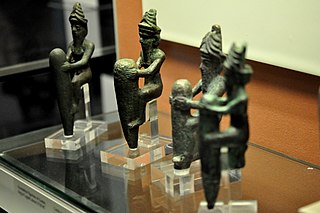
The Anunnaki are a group of deities of the ancient Sumerians, Akkadians, Assyrians and Babylonians. In the earliest Sumerian writings about them, which come from the Post-Akkadian period, the Anunnaki are deities in the pantheon, descendants of An and Ki, and their primary function was to decree the fates of humanity.

The Pantheon is a former Roman temple and, since AD 609, a Catholic church in Rome, Italy. It was built on the site of an earlier temple commissioned by Marcus Vipsanius Agrippa during the reign of Augustus ; then, after the original burnt down, the present building was ordered by the emperor Hadrian and probably dedicated c. AD 126. Its date of construction is uncertain, because Hadrian chose not to inscribe the new temple but rather to retain the inscription of Agrippa's older temple.
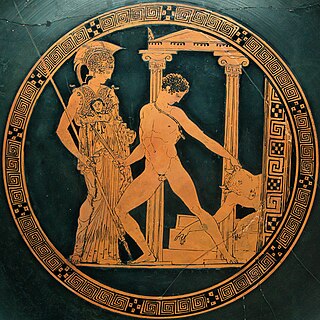
In ancient Greek religion and mythology, the twelve Olympians are the major deities of the Greek pantheon, commonly considered to be Zeus, Poseidon, Hera, Demeter, Aphrodite, Athena, Artemis, Apollo, Ares, Hephaestus, Hermes, and either Hestia or Dionysus. They were called Olympians because, according to tradition, they resided on Mount Olympus.
Ancient Semitic religion encompasses the polytheistic religions of the Semitic peoples from the ancient Near East and Northeast Africa. Since the term Semitic represents a rough category when referring to cultures, as opposed to languages, the definitive bounds of the term "ancient Semitic religion" are only approximate but exclude the religions of "non-Semitic" speakers of the region such as Egyptians, Elamites, Hittites, Hurrians, Mitanni, Urartians, Luwians, Minoans, Greeks, Phrygians, Lydians, Persians, Medes, Philistines and Parthians.
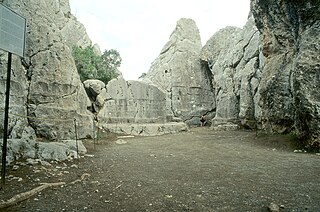
Yazılıkaya was a sanctuary of Hattusa, the capital city of the Hittite Empire, today in the Çorum Province, Turkey. Rock reliefs are a prominent aspect of Hittite art, and these are generally regarded as the most important group.

A pantheon is the particular set of all gods of any individual polytheistic religion, mythology, or tradition.
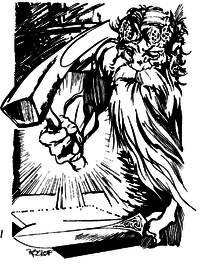
Moradin is the chief deity in the dwarven pantheon in the Dungeons & Dragons game and is a member of the default D&D pantheon. In 3rd edition, Moradin's domains are Creation, Earth, Good, Law, and Protection. The 5th Edition Players Handbook include Knowledge as a suggested domain. His titles include Soul Forger, Dwarffather, the All-Father, and the Creator. He created the first dwarves out of earthen materials and tutored them in dwarven ways.

Armenian mythology originated in ancient Indo-European traditions, specifically Proto-Armenian, and gradually incorporated Hurro-Urartian, Mesopotamian, Iranian, and Greek beliefs and deities.

As polytheistic systems evolve, there is a tendency for one deity to achieve preeminence as king of the gods. This tendency can parallel the growth of hierarchical systems of political power in which a monarch eventually comes to assume ultimate authority for human affairs. Other gods come to serve in a Divine Council or pantheon; such subsidiary courtier-deities are usually linked by family ties from the union of a single husband or wife, or else from an androgynous divinity who is responsible for the creation.

Hera is a fictional deity appearing in American comic books published by Marvel Comics. The character is based on the Greek Goddess of the same name. Hera first appeared in the pages of Thor #129, written by Stan Lee and drawn by Jack Kirby.
Faiths & Avatars is an Advanced Dungeons & Dragons Forgotten Realms campaign expansion book.
Bebrycius or Bebryx, in Greek mythology, was a king and the father of Pyrene. The mythical tribe of the Bebryces is presumably named after a hero named Bebrycus.

Cotyttia was an orgiastic, nocturnal religious festival of ancient Greece and Thrace in celebration of Kotys, the goddess of sex, considered an aspect of Persephone.
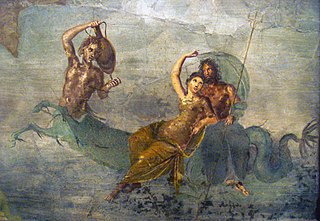
In ancient Roman mythology, Salacia was the female divinity of the sea, worshipped as the goddess of salt water who presided over the depths of the ocean. Neptune was her consort. That Salacia was the consort of Neptune is implied by Varro, and is positively affirmed by Seneca, Augustine and Servius. She is identified with the Greek goddess Amphitrite, consort of Poseidon, or Tethys who was also a marine deity.
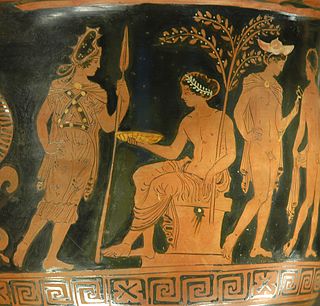
Kotys, also called Kotytto (Κοτυττώ), was a Thracian goddess whose festival, the Cotyttia, resembled that of the Phrygian Cybele, and was celebrated on hills with riotous proceedings and orgiastic rites, especially at night.
Theros is a set of three expansions to the Magic: The Gathering game, consisting of the sets Theros, Born of the Gods and Journey into Nyx. The setting was later used for a Dungeons & Dragons sourcebook, Mythic Odysseys of Theros (2020). The lore and aesthetics of the game setting was based on Greek mythology.

In Greek mythology, Manto was the daughter of the prophet Tiresias and mother of Mopsus. Tiresias was a Theban oracle who, according to tradition, was changed into a woman after striking a pair of copulating snakes with a rod, and was thereafter a priestess of Hera.

Pantheon is a steel roller coaster at Busch Gardens Williamsburg theme park in Williamsburg, Virginia. Manufactured by Intamin, the roller coaster opened to park members on March 4, 2022 and features four launches, five airtime hills, and a 95-degree beyond vertical drop. The 178-foot-tall ride (54 m) inverts riders twice and reaches a maximum speed of 73 mph (117 km/h). Its theme is set to ancient Rome with a focus on the ancient culture's deities Jupiter, Mercury, Minerva, Neptune and Pluto. Despite marketing for the ride, it has never held the fastest multi-launch coaster record. Soaring With Dragon held this record from September 2016 until May 2024 with Cedar Point opening Top Thrill 2.